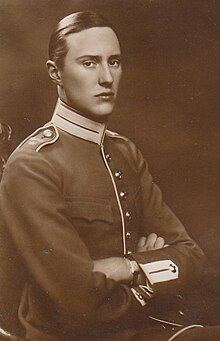Carl Gustaf Oscar Fredrik Christian, Prince Bernadotte (10 January 1911 – 27 June 2003), originally Prince Carl, Duke of Östergötland, was the youngest child and only son of Prince Carl of Sweden and Princess Ingeborg of Denmark and eventually a prince of the Belgian nobility. To distinguish himself from his father, he was widely known as Carl Junior. He was the brother of Princess Margaretha of Sweden, Queen Astrid of Belgium and Crown Princess Märtha of Norway.
| Carl | |||||
|---|---|---|---|---|---|
| Prince Bernadotte | |||||
 Prince Carl in the 1930s | |||||
| Born | 10 January 1911 Stockholm, Sweden | ||||
| Died | 27 June 2003 (aged 92) Málaga, Spain | ||||
| Spouse |
Countess Elsa von Rosen
(m. 1937; div. 1951)Anna Margareta (Ann) Larsson
(m. 1954; div. 1961)[1] | ||||
| Issue | Countess Madeleine Bernadotte | ||||
| |||||
| House | Bernadotte | ||||
| Father | Prince Carl, Duke of Västergötland | ||||
| Mother | Princess Ingeborg of Denmark | ||||
Marriage and loss of status
editWhen Prince Carl married Countess Elsa von Rosen (1904–1991), on 6 July 1937 at Kvillinge, Sweden, he had to relinquish his succession rights and his royal titles. She was the daughter of one Count von Rosen and ex-wife of another Count von Rosen. Bernadotte's brother-in-law, King Leopold III of the Belgians, conferred upon him the title of Prince Bernadotte in the Belgian nobility on the same date, with the right to a comital title for his male-line descendants. They had one daughter, Countess Madeleine Bernadotte (Madeleine Astrid Ingeborg Ella Elsa, born in Stockholm, 8 October 1938), and were divorced in 1951. Through his daughter he was grandfather of Belgian actress Astrid Whettnall.
He married secondly Anna Margareta (Ann) Larsson (1921–1975) at Danderyd, Sweden, on 1 November 1954. They divorced in 1961 without issue. His third and final marriage took place at the Embassy of Sweden in Rabat, Morocco, on 8 June 1978, when he married Kristine Rivelsrud.[1][2]
Bernadotte died at the age of 92 on 27 June 2003 in Málaga, Spain. He was the last surviving grandchild of Oscar II of Sweden. His widow, Princess Kristine Bernadotte, died at their home at Villa Capricornio in Benalmadena, Spain, on 4 November 2014 at the age of 82, without issue.[3][4] His daughter Madeleine married Belgian Count Charles-Albert Ullens de Schooten-Whettnall (1927–2006) in 1962. The couple had four children and were divorced in 1980. She subsequently the same year married the Nicolaos "Nicos" Kogevinas with whom she has a daughter. She was widowed in 2006.
The Huseby scandal
editCarl Bernadotte was at the centre of the Huseby scandal that occurred in the late 1950s in Sweden amidst a great deal of publicity. Bernadotte and other suspects had gained the trust of Florence Stephens, a wealthy elderly heiress of a large estate near Växjö in southern Sweden. A complex set of criminal transactions led to the ruin of Stephens and brought Bernadotte and the others to court. Bernadotte was acquitted, in spite of his full confession – it was considered that he had no criminal intent. Bernadotte left Sweden shortly after the trial and spent the rest of his life in Spain.
Honours and arms
editHonours
edit- Sweden:[5]
- Knight and Commander of the Royal Order of the Seraphim, 10 January 1911
- Knight of the Royal Order of Charles XIII, 10 January 1911
- Belgium: Grand Cordon of the Order of Leopold[6]
- Denmark: Knight of the Order of the Elephant, 5 December 1933[7]
- Empire of Japan: Grand Cordon of the Order of the Rising Sun[6]
- Norway: Grand Cross of the Royal Norwegian Order of Saint Olav, with Collar, 19 March 1929[8]
Arms
edit| Arms of Prince Carl, Duke of Östergötland from 1911 to 1937 |
Bernadotte's arms after 1937[9][10] |
Ancestry
edit| Ancestors of Carl Bernadotte | |||||||||||||||||||||||||||||||||||||||||||||||||||||||||||||||||||||||||||||||||||||||||||||||||||||||||||||||||||||||||||||||||||||||||||||||||||||||||||||||||||||||||||||||||||||||||||||||||||||||||||||||||||||||||||||||||||||||||||||||||||||||||||||||||||||||||||||||||||||||||
|---|---|---|---|---|---|---|---|---|---|---|---|---|---|---|---|---|---|---|---|---|---|---|---|---|---|---|---|---|---|---|---|---|---|---|---|---|---|---|---|---|---|---|---|---|---|---|---|---|---|---|---|---|---|---|---|---|---|---|---|---|---|---|---|---|---|---|---|---|---|---|---|---|---|---|---|---|---|---|---|---|---|---|---|---|---|---|---|---|---|---|---|---|---|---|---|---|---|---|---|---|---|---|---|---|---|---|---|---|---|---|---|---|---|---|---|---|---|---|---|---|---|---|---|---|---|---|---|---|---|---|---|---|---|---|---|---|---|---|---|---|---|---|---|---|---|---|---|---|---|---|---|---|---|---|---|---|---|---|---|---|---|---|---|---|---|---|---|---|---|---|---|---|---|---|---|---|---|---|---|---|---|---|---|---|---|---|---|---|---|---|---|---|---|---|---|---|---|---|---|---|---|---|---|---|---|---|---|---|---|---|---|---|---|---|---|---|---|---|---|---|---|---|---|---|---|---|---|---|---|---|---|---|---|---|---|---|---|---|---|---|---|---|---|---|---|---|---|---|---|---|---|---|---|---|---|---|---|---|---|---|---|---|---|---|---|---|---|---|---|---|---|---|---|---|---|---|---|---|---|---|---|
| |||||||||||||||||||||||||||||||||||||||||||||||||||||||||||||||||||||||||||||||||||||||||||||||||||||||||||||||||||||||||||||||||||||||||||||||||||||||||||||||||||||||||||||||||||||||||||||||||||||||||||||||||||||||||||||||||||||||||||||||||||||||||||||||||||||||||||||||||||||||||
References
edit- ^ a b c d "Prince Carl Bernadotte". The Daily Telegraph. 2003-07-17. Retrieved 2014-12-06.
- ^ Holst Poulsen, Victoria Rogena (2014-11-16). "Swedish and Norwegian royals at funeral of Princess Kristine". Royalista. Archived from the original on 2014-12-08. Retrieved 2014-12-06.
- ^ "Una princesa en Málaga: Fue la tercera esposa de Carlos, con quien siempre vivió en Villa Capricornio, en Benalmádena". La Vanguardia. 2014-11-11. Retrieved 2014-12-06.
- ^ Isaksen, Trond Norén (2014-11-10). "Nekrolog: Prinsesse Kristine Bernadotte". Aftenposten. Retrieved 2014-12-06.
- ^ Sveriges statskalender (in Swedish), vol. 2, 1931, p. 6, retrieved 2018-01-06 – via runeberg.org
- ^ a b Sveriges statskalender (in Swedish), vol. 2, 1955, p. 7, retrieved 2018-01-06 – via runeberg.org
- ^ Bille-Hansen, A. C.; Holck, Harald, eds. (1963) [1st pub.:1801]. Statshaandbog for Kongeriget Danmark for Aaret 1963 [State Manual of the Kingdom of Denmark for the Year 1963] (PDF). Kongelig Dansk Hof- og Statskalender (in Danish). Copenhagen: J.H. Schultz A.-S. Universitetsbogtrykkeri. p. 18. Retrieved 16 September 2019 – via da:DIS Danmark.
- ^ "Den kongelige norske Sanct Olavs Orden", Norges Statskalender for Aaret 1930 (in Norwegian), Oslo: Forlagt av H. Aschehoug & Co. (w. Nygaard), 1930, pp. 995–996 – via runeberg.org
- ^ Nordenvall, Per (1998). Kungliga Serafimerorden: 1748-1998 (in Swedish). Stockholm: Kungl. Maj:ts orden. p. 440. ISBN 91-630-6744-7. SELIBR 8364835.
- ^ Berghman, Arvid (1944). Dynastien Bernadottes vapen och det svenska riksvapnet. Skrifter / utgivna av Riksheraldikerämbetet, 99-2298099-1 ; 1 (in Swedish). Stockholm: Svensk litteratur. pp. 71–72 & 117–118. SELIBR 1166850.